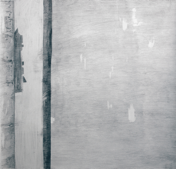

Derrida’s idea of deconstruction is associated with the attempt to expose and undermine the oppositions, hierarchies, and paradoxes on which particular texts, philosophical and otherwise, are founded.

Avram Noam Chomsky (born December 7, 1928) is an American linguist, philosopher, cognitive scientist, logician, historian, political critic, and activist.
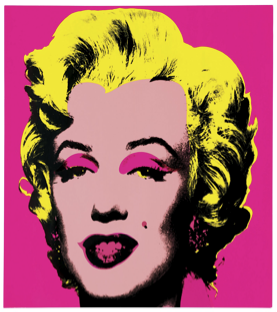
“Marilyn” is a silkscreen on canvas painting produced in 1964 by Andy Warhol, whose works explore the relationship between artistic expression, celebrity culture, and advertisement that flourished by in the 1960s.
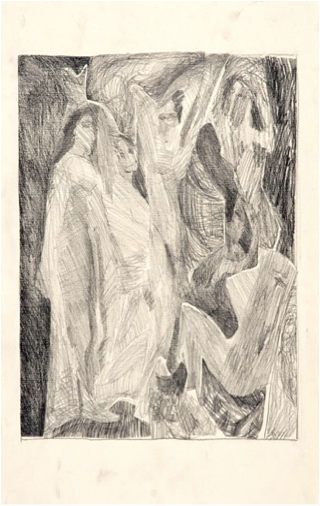
“After Picasso” (2012) pencil on paper by Lidija Slavkovic. Les Demoiselles d’Avignon (The Young Ladies of Avignon, which was originally titled The Brothel of Avignon) is a large oil painting created in 1907 by the Spanish artist Pablo Picasso (1881–1973).
Her drawing of the Picasso was motivated by her wanting to view its parts separated from the insistence of the illusion of their continuity. In this she discovered that the struggle to resist this persistence is a false one in that it only in the end secures the whole. The opposition that underlies such a struggle is masculine in principle, in that it is a manifestation of either/or logic, while the embrace of the paradoxical nature of the thing as neither one nor the other is feminine. In this aspect, these texts might be thought to assert a feminine principle that knows no singularity, for there is nothing to return to, for all that there ever is, is an alignment of differing positions. An Ambition, therefore, may be thought to be comparably a dialogue concerning the feminine and masculine weaving in and out of each other in their respective incompleteness, in that each in itself is nothing. The incompleteness of An Ambition is a manifestation of a variety of irreconcilable differences that fracture its form, producing a network of fissures which transverse its Subject.
This condition is a result of their resistance to the idea of setting into place a programmatic sequence of actions that may be abstracted and extended into rules that form restrictions. The gaps and rips in An Ambition’s fabric, and the sutures that hold it together, are what keeps these texts from becoming a description of a standard operating procedure, or from becoming a formula, an algorithm, a set of instructions, a program, a system, a recipe, or a user’s manual. In part, this may be a result of the fact that An Ambition avoids generalizing its problem into a knowledge/experience antagonism, or some other such dichotomy. As such, through An Ambition one may arrive at the recognition that while we must operate within a certain system, that system is not necessarily a reliable grounding—and thus cannot give its user a claim to mastery over (material and conceptual constructs). In this, we find traces of the feminine nature of An Ambition put into motion by its apparent masculine indifference to the question of how such freedom may come to be known without creating another limiting “self-reproducing truth” (machine) that will hijack its own means, resulting in the disappearance of the Subject, again.

Adolph Frederick Reinhardt (“Ad” Reinhardt) (December 24, 1913–August 30, 1967) was an abstract painter most famous for his “black” or “ultimate” paintings, he claimed to be painting the “last paintings” that anyone can paint.
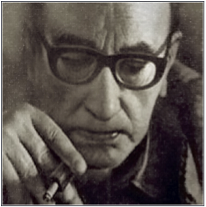
Mikhail Mikhailovich Bakhtin (November 17, 1895, Oryol–March 7, 1975, Moscow) was a Russian philosopher, literary critic, semiotician and scholar who worked on literary theory, ethics, and the philosophy of language.

Ad Reinhardt is best known for his so-called “black” paintings of the 1960s, which appear at first glance to be simply canvases painted black but are actually composed of shades of differing blacks.
Her refusal to achieve anything manifests itself in those parts of her drawings that do not necessarily reconcile their selves to the whole—that is; they do not submit to playing a role in establishing some seamless whole. This results in her work at times having the appearance of being uncorrected, unfinished, or undone. One might suspect from her awareness that her desire to know some things about incompleteness as a condition, she has willfully deferred those qualities that would evermore with their repetition create a unity. But to validate and conserve her project in such a manner would transform her hypothesis into a trope or a vanity and as such into some artificial, and aesthetic “thing.” In good faith such contrivances would not permit her inquiry to advance; they would instead necessitate her engagement in further acts of deception so she might self-consciously make incomplete works. This for her would result in a form of self-erasure: the very condition she tells me that she desires to overcome by means of her work.
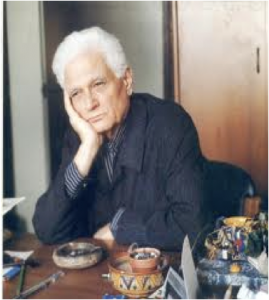
Derrida viewed identity in non-essentialist terms as a construct, because constructs only produce meaning through the interplay of differences inside a “system of distinct signs.”
She experiences, and believes that the disparities within each work opens, a space from which the viewer may “recognize” that these contrasts are not meant to offer an invitation to correct (repair) the work but to experientially, and then textually, construct an understanding of it as it is. The disparity as either an exception to the rule or as an event that is willfully inexplicable serves as a prompt (signal) to the viewer that new generalizations (interpretations) are to be formulated. In this, her work can be thought to involve antinomies (logical or pictorial discrepancies) to unsettle or subvert the normal means by which one might construct an understanding of the limits (boundaries) and potential (reserves) of the conditions under which she works, and those that she creates. Reciprocally, the contrasts (disparities) within each work conceal something potentially more significant as these various incongruent elements (qualities) form anomalies (elements difficult to identify, or classify), which within the context of the rules of her discipline make the drawing atypical (uncharacteristic) of its genre. In this way each work becomes a “Case;” an event that defies a straightforward application of a singular unifying logic. It instead requires intellectual ingenuity (arguments) to classify and resolve (accommodate) the logic of its presence.
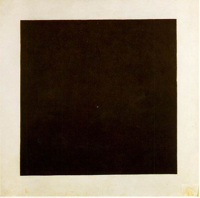
Black Square, 1915, Oil on Canvas, Kazimir Severinovich Malevich (23 February 1879 – 15 May 1935) was a Russian painter and art theoretician. He was a pioneer of geometric abstract art and the originator of the avant-garde Suprematist movement.
Following her logic, the application of a given regime (system of rules or fixed referents) within each work is simultaneously desirable and undesirable. Subsequently, within the context of a rule-driven order, the anomaly (a glitch for instance) that she introduces informs us more about the nature of rules than the rule can express about either the disparity it is meant to repress or its “self.” Therefore the anomaly (the exception) is always ontologically defined by the rule; but the rule, not the system it promotes, is not defined by what it seeks to exclude (prohibit). The inclusion of what should be voided by the rule establishes that her work has an epistemological function (purpose); yet given her ambition she does not seem concerned with formulating new rules but simply will investigate the invisible structures generated (organized and concealed) by the rules and amplified by the anomaly. In doing this she renders both the rules’ multiplicity (diverse forms, contents, and functions) visible and the potentiality (virtuality) that it might make unthinkable.
By exposing what the rule represses, she inhibits the practice of reducing complex and multifaceted situations to simplify an object. This description of the anomaly’s function requires that a differentiation be made between making sense of the ordering of the work’s relationships and fixing meaning to signifiers. Based on the effect of this destructuring (critical analysis) of the rule, one can inductively conclude that the sum of the parts of any one of her works is greater than the whole (its entirety). Her inquiry into the nature of rules by means of their exceptions need not establish a didactic program, one that instructs her audience. As with most aspects of her work, while such a program is present, it is not what the work is about (focused on). Again, we might also recognize that if the work were only positioned to demonstrate some function, it would be counter to her stated ambition (her rule) of not achieving anything (that is to not complete something as intended or with a projected result).
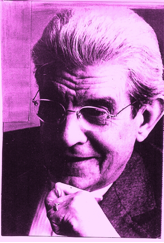
Jacques Marie Émile Lacan (April 13, 1901 – September 9, 1981) was a French psychoanalyst and psychiatrist and has been called “the most controversial psycho-analyst since Freud. Lacan’s post-structuralist theory rejected the belief that reality can be captured in language. His ideas have had a significant impact on critical theory, literary theory, sociology, feminist theory, film theory and clinical psychoanalysis.
At this point I turn to her words which, while substantially written by her, have been edited and stylized by me and in this I try to make them our words. Though this crafting of her words happens throughout the text, here I make this apparent because she would have me be attentive to what goes to the question of motivation—which is something rooted in her experiences and desires. Consequently, she insists that it be made clear that the results of making visible (apparent) the operation of rules is not an end in itself—nor is the fact that it is an example of how the rule is not an objective or autonomous thing but merely a convenience. She is instead insistent that she makes the work to neither merely expose such conditions nor because she is particularly concerned with them. Yet, in a manner even this amended representation corresponds to her complaint that I continue to think of rules in concrete terms rather than merely something subscribed to. This has led me to imply that she and I are to operate freely within the rules in place here, as a non-existent, non-concrete, transparent concepts “containing” operations that are both capable of “materializing” our intentions as well as forming them—to understand rules in this manner is not to dismiss their concreteness, but to return them to the maker of the rule.
She feels that rules have won a “materiality” over actual being. To reduce their values to a scheme which can in effect be ignored would “dematerialize” them (making them nothing) and therefore it would be our attention to the rule that would make it actual and in doing so calling for attention to the small habits of the everyday world that present themselves as external rule. In this context she understands negation is never just a negation. In this she would move beyond the simple stable binary logic that does not account for the lived experience. She also would have me impart here how she proceeds to characterize what she has chosen to do as an attempt to restore “belief” by building on zero ground, exploring what may be useless. After I had written this account and she had read it, she sent to me a message concerning Jean Luc Marion (whose book she is reading while I’m writing this) because she has found in his text on love a strange affinity; one that seemingly reflects the attitude she has when she is drawing.
Marion’s text questions tacit knowledge, the inability to explain (create a standardized account or instruct another) what one “knows.” In this case this is effectively her self-view concerning the “scheme” of her drawing and the manner that she goes about “filling it in” (explicating it). She says that through his text she recognizes that the “scheme” (which is either a format, and/or a plan) is always a “throw” (a risk or perhaps a deposited obstacle). This condition reflects her feeling that each time she begins to work something within the image must be lost, so that in the process of making, it may be found (it is made to reappear). She connects the ability to transcribe and make palpable an image to her experience as an icon writer, in which there is simultaneously a sense of intimacy (sensitivity and security) and distance (remoteness). This is what permits her to say that the “scheme” she adopts, or adapts for each image, is traceable to something unchangeable but insignificant within the image itself—it connects to some passive fact, some nothing that one forgets, ignores or goes unnoticed.
In each image she makes this nothing, absent quality, or causeless affect, occupy its own place by assuming an inconspicuous though fundamental role. At best, she describes this ineffable quality as being similar to a conversation about random things—a thoughtless conversation without an agenda (topics and issues to be addressed). Such conversations in which the intention/attention given is in its self nothing—its form, motive, or objective can not be seen—yet, it appears (materializes). This constant that goes unrecognized, but around, through which we may organize our ideas and practices. She suspects this corresponds to her intuited idea of a “nothing that is never simply nothing.” She tells me this was expressed in a message she had sent to me, which read: “I have nothing to say to you – (yet we say a lot to one another).”

Composite #1, graphite pencil on paper, 2012. Slavkovic in her works accepts the notion that consistency as a medium does not represent an escape from the reality of her drawings but a way into their nothingness.
The viewer, by immediately assigning a canonical standards and criteria created by the Subject (the maker), suppresses their own anxiety brought on by their uncertainty. The desire of the observer to restrict the drawing’s ever-shifting signifiers is a response in part to a fear that the work’s otherwise familiar appearance represents a disembodied Subject: a ghost, or an apparition of meaning. The resulting Subject without body exists in the presence of its other: a body without organs—an empty shell with only implied function (a cadaver). In this state the “body” is a vessel waiting to be filled, not with a presence but with substance (appreciative data, a subject). If this is what she aspires to, the drawings would appear to be little else than a waiting room—uniform in its organization and generically furnished. Later in our conversations, she refers again to how the expectations induced by her work’s lack of rightness comes to be misread and then understood by the viewer/reader as an invitation to correct rather than finish the work.
When the viewer takes on the notion that it is their task to fix the work (repair and keep in its place), it is internalized as normative; all other possibilities regardless of the evidence to the contrary are problematically negated or denigrated. We can understand how, on the part of the recipients, their desire to symbolically capture the “thing” results in their believing that the elaboration of the Subject (the principle text) of the work is their primary task. It is in the face of this economy of what is to be interpreted and who metaphorically speaks that her analysis and self-reflection concerning her own work arises, for the question is not one of communicating a sense of rightness, but of what may permit another view based the authority of our own experience to proceed to openly speculate. This raises the question of how the viewer’s desire to gain mastery might be exploited, resisted, or re-deployed so as to retrieve the economy of indetermination, given that the material conditions of consciousness and desire cannot to be willed away.
Within the context of will and desire (which is a reoccurring theme in our dialogues) I understand that, short of having the ability to order and organize work, she would like to be ‘freed’ from the authorship that emerges out of each layer of inquiry (marks). The fact is, she is willing to relinquish to the viewer the textual content of her works in accord with their ability and knowledge. Roland Barthes proposed that the reader through their interpretation over-writes or re-writes the text and in doing so effaces it or erases the division between the author and the reader. The freedom that this affords is a double bind—opening one door, closing the other at the same time—as in Marcel Duchamp’s apartment in which the front door also served as the bathroom door. If the maker/author is not an apparatus, then the reader /author is; and vice versa, as one vanishes the other appears. At some point in one of our conversations, we had a discussion concerning authors as living/dead and undead, or absent, each a state that is relative to the various circumstances and functions of their production. What differentiates the two, author and reader, here is that the reader authors with different tools and goals.
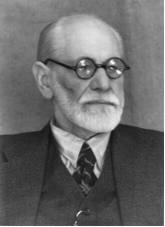
Sigmund Freud (6 May 1856 – 23 September 1939), , was an Austrian neurologist who became known as the founding father of psychoanalysis. He developed theories about the unconscious mind and the mechanism of repression, and established the field of verbal psychotherapy by creating psychoanalysis, a clinical method for treating psychopathology through dialogue between a patient (or “analysand”) and a psychoanalyst.
After reading the previous section she told me she had many self-doubts about what it was that she and her work were in actuality actually doing. This text as an objectification—a distancing (a throw) and consolidation (a return)—had undermined her ability to speak about what she sees and instilled a doubt about what to say, and to whom. She felt a sense of estrangement from the text as well as the paradoxical nature of her project. This expressed itself as a sense of loss (the throw), a not knowing if she had somehow deluded herself and in actuality was just an inventor of false obstacles and struggles (calculated risks), and that perhaps the problems that she thought were rooted in experience weren’t even problems but were only of her own invention. In this moment she expressed her suspicions, her uncertainty, saying that she would like to know if the paradox and obstacles she employs were a result of her invention (the return), some coping mechanism reflecting some fort/da game inherent in our lives. By this I am not sure if she meant the two of us, or everyone’s life.
Fort/Da is a reference to Freud’s observations and analysis of his grandchild’s “game” of disappearances, re-appearances and the pleasure taken in the return. Briefly the game of fort/da consisted of taking small objects and throwing them away, into a corner, or under the bed. This was accompanied by an expression of satisfaction (fulfillment) which Freud interpreted as the word “fort” (gone). Some 18 months later Freud observed the child playing with a reel that had a piece of string tied around it: the child would toss the reel away from him to where it could no longer be seen. Before pulling it back into view he would hail its reappearance by pronouncing “Da!” (“There!”). The boy extended this game to include himself when, by crouching down below a mirror, he made his image disappear. He would announce it with the term fort, which indicated the pleasure he obtained from making the other things as well as himself disappear. Freud interpreted this pleasure as compensatory—a way to make tolerable the violence that absence implies. The da, which is founded on disappearance and reappearance, is a different kind of pleasure from that felt when what is thought to be gone forever returns from the void. In this, the possibility of permanence, of continuity, is discovered—a necessity for the workings of the symbolic order as well as the imaginary.
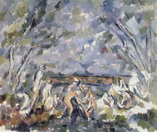
Paul Cézanne (1839–1906) was a French artist and Post-Impressionist painter whose work laid the foundations of the transition from the 19th century conception of artistic endeavor to a new and radically different world of art in the 20th century.
The nature of the return (and the pleasure associated with it) raises the issue of consciously or unconsciously producing a false obstacle (the object attached to a string becomes habit, with the certainty of the return.) The idea that her drawing may function in this manner now causes her to doubt. I argue that such a possibility is the affect of the surplus produced by an asymmetrical economy. Likewise it is but one result alongside many other by-products. The paradoxes so produced, some desirable and others not, are a result of the fact that what her drawings address is not singularity, but the creation of heterogeneous fields. This is why what she puts at risk in her drawings returns as something other (the lesson, the rule, the anomaly, etc.). Subsequently both da and fort are present within the work and their antithetical relationship negates both cause (disappearance) and affect (the pleasure of the reappearance) because in actuality da cancels out the risk factor of fort in which the object thrown may never return, or what is returned is an object long thought lost. But none of this will assuage her doubts or fears, nor stem her arguments.
So she goes on to question: If what might disappear by means of her drawings might not also give rise to a too-strange feeling of enjoyment at its re-appearance. The thing’s imagined resurrection is not in kind but with a difference. Again she turns to the possibly masochistic feeling that is gained by causing fear in oneself, which is possibly sadistic when inflicted on another: This after all is the risk that lies in fort. While the return in da is the opposite—the thing returned literally becomes little more than evidence that the thing was gone. Perhaps this is the enjoyment caused by the motif of fort/da, which is implicit both in her drawings as well as the condition of our lives. To this I could only understand her point relative to the notion of an absence and its impermanence. For me, absence functions in the way that the anomalies in her drawings do, it secures the rule and makes its presence and bounds (limits) apparent. To this she notes critically that this is what it means to create a false struggle, for the disparity induced by the anomaly may result in a distraction (the presence of some other) which in turn would make her work didactic. Therefore, I am using da to create a false struggle that, if actual, would afford her the means to overcome an absence by permitting a continuity to be discovered and guaranteed. As such, fort may be more desirable, for the absence has no guarantee of return—making clear that not to risk the throw (the disappearance) is to lose the possibility (not the promise) of the pleasure of a return.

Composite #4, pencil on paper, 20012 – Lidija Slavkovic excludes one surface from the rest (by covering them) and then works on it as if it is a shape to be “filled in” with marks, lines, values. This is done regardless of the top-bottom direction suggested by the image (landscape, building, whatever).









